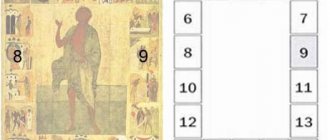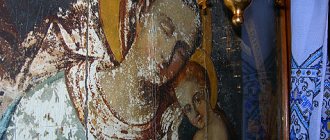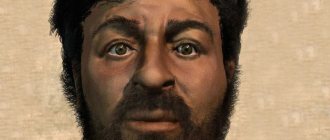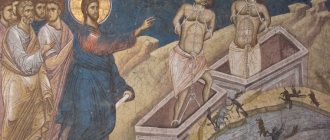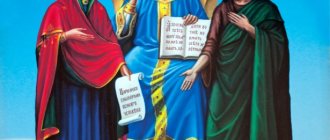If He looked into your eyes...
Based on materials from the lecture “Ancient Russian painting. Conversation about the icons of the Tretyakov Gallery,” read at the Ryazan Regional Universal Scientific Library. Gorky as part of the “Word and Image” cycle on the initiative of the cultural and educational foundation “Preobrazhenie”.
Alexander Arkhangelsky. Photo: Evgeny Gurko
Speaking about ancient Russian icons, we will not touch on those things that can easily be found on the Internet, in the catalog of the Tretyakov Gallery. We will talk about images and symbols so that this space comes to life as much as possible.
“Icon” in translation means “image”. A person thinks in images, copies images in his behavior. An icon doesn’t just talk about something, it affirms certain things and actively opposes something. Prince Evgeny Trubetskoy wrote that the icon affirms the godlikeness of man in a world where many people claim that man is beast-like.
Dmitry Solunsky, mosaic
This is a 12th century mosaic icon and the saint is depicted here. When we talk about the image of a holy person, we use the word “face”. A person in his life can show either a guise (mask), or a face, or a face. A mask appears when a person wants to show something that is not really there, or to hide something. The mask does not reflect the essence of what is inside. But what are we talking about when a face is depicted? What is the difference between a face, a portrait and a face? Charles Baudelaire wrote that “a good portrait is a dramatized biography of the model - the revelation of the natural drama inherent in every person.” Why biography? Knowledge of the goals, values, life, biography of the model is very important for the artist. A person can express a variety of emotions in just one hour: joy, sadness, fatigue, inspiration, despair. But not everything that a person reveals expresses the most important thing in him, his path, his work, in which he embodies his calling, as he understands it. The task of a portrait painter is to highlight the characteristic, the main thing, which expresses the very essence of the person he paints. In addition, a portrait is always a drama, a clash of opposite principles in a person. If the impersonal animal nature wins, then a person ceases to be a person in a certain sense. But, in addition to the spontaneous, natural, two spiritual “principles” also fight in man. Faith in the Creator, which tries to restore the image of God in man, leading him forward and upward, and that spiritual breakdown that drags man back and down, which is the result of the Fall. The victory of God over this breakdown is affirmed and manifested in the face, what is called the image of God. It’s like an icon cleared of blackness: a person makes a spiritual choice, lives in accordance with this choice, and this is manifested in the fact that peace comes to the heart, the face becomes a face. This change involves both human labor and the manifestation of God’s participation.
On the icon of saints we see a halo. The halo expresses that reality, that experience that almost every adult has, sometimes regardless of whether he calls himself a believer or not. They say: a “dark” person and a “light” person. This, of course, is not about hair color, this is the internal experience of discerning the light of the non-human, this is the light that shines through a person if the person has certain qualities, openness to God and His light.
Dmitry Solunsky is dressed in armor. In his left hand he has a shield, in his right hand there is a spear, on his hands there are guards, he is a military man. But on the icon, the armor and weapons indicate not so much his military affiliation as spiritual images. Pay attention to the guards: these are not military, not combat guards (up to the elbow, when you can protect yourself from a blow). Here they are more like the priest's handrails - a symbolic thing, a sign of dedication and service. Or a spear: look how thin it is, like a reed, it is impossible to pierce anything with this spear. He leans on this spear like a staff. When you look, the image of the saint as a shepherd is born. In the apostolic epistles there are such words: put on the breastplate of righteousness, take the shield of faith, the helmet of salvation. What is the “armor of righteousness”? I often ask students from different universities with whom I visit halls of icons, what is this? To make this image clear to them, I sometimes give them an example. One of my acquaintances talked about his friend who lives in one of the CIS countries, a decent, honest person, a teacher. But one day a student offered him a bribe. It was an offer that was difficult to refuse, given that at that time he had a need... He accepted it - and then certain people from certain structures appeared and said: either you are imprisoned for a long time, or now you will regularly tell us what students and teachers at your university think and say about politics. And this decent man faced a very difficult choice. In another situation, he would have refused, since informing on his colleagues was disgusting to him. But here... You have to be responsible for everything in life. This is the moment when a person, making a spiritual mistake, is deprived of this very armor of righteousness. Righteousness is the ability to act according to the law, in truth. The armor of righteousness is when evil has nothing to catch a person on. Those who live in truth have much fewer such “clues.”
What could be behind the image of the “shield of faith”? Faith has several definitions. For example, confidence in the invisible. Another definition: faith is openness to what a person believes in, he is open. If a person believes that salvation is in his summer cottage, he will spend his whole life there, growing carrots, and that’s all he will read and think about... If he believes that salvation is in his career, he will bet his whole life on it. The apostle speaks of a different faith and much hope. But if a shield is closedness, security, and faith is openness? But you and I understand, Who will protect a person, Who will become his shield if he is open to God? I think this is clear. The same applies to the rest of the symbolism - shoes (good news), helmet (hope).
Spas Emmanuel
We are accustomed to the fact that Christ on icons is often depicted either as a baby in the arms of his mother, or as an adult. And behind each of these two images there is something important. For example, the baby in the arms of the Mother of God expresses the mystery of the Incarnation. Such an icon should help a person to realize this reality, to think about what it means “God became incarnate”?
Spas Emmanuel, if you don’t get distracted by the high adult forehead, is a youth, that is, a teenager no older than 16 years old. Why is He depicted as a youth? Savior Emmanuel is Christ, who has not yet been born in the flesh, about whom the prophets are only saying that He will come and be incarnate. This image appears at a certain spiritual stage in the relationship of God’s people with God.
To better understand the meaning of the image of the youth Emmanuel, it is important to remember the steps that preceded this spiritual stage. The so-called Old Testament is a set of books that tells not about one covenant (agreement) between people and God, but about all the covenants that existed before the coming of Christ. Each such covenant agreement is a certain spiritual stage at which a person accepts new knowledge about God, the world, other people and himself and enters into these new relationships. The first covenant - with Adam, as we remember, ended in collapse, fall, alienation. Man became a stranger to God, and through this to other people, and split within himself. And then the story of restoring this relationship began. Every person, coming to God, goes through the same stages. The first step on this path was the covenant with Noah. Noah did not have the same relationship with God that Abraham later had. He lived in truth, knowing that “there”, above, there is a Creator, but neither the Law was revealed to him to the same extent as it was to Moses, nor did he know how to obey , like Abraham. But he lived in truth, knew that certain things should not be done, was ready for the fact that God might turn to him, and he turned out to be ready to hear God. And I heard it before the flood. Likewise, modern people, whose faith is at the level of the Noahic Testament, often do not go to the temple, they do not know the Law of God, but they believe and know that God exists, and have an inner readiness to fulfill His will. This manifests itself especially often when in the life of such a person or in the lives of those whom he loves, some serious crisis, trouble, “flood” occurs or is brewing, and then such a person suddenly begins to take something drastic, something that he I didn’t usually do this before: go to church, light candles, order magpies, in general, “build an ark,” make some kind of effort to save yourself. The Abrahamic faith (including that of modern man) is already different, it manifests itself differently. A person who lives by such faith as Abraham talks to God every day, tries to figure it out, to hear what is good and bad in his life, not in God’s way. He learns to obey , that is, he tries to listen and hear God every day. The next step is the covenant with Moses. In a sense, it was easier for Abraham than for Moses: he had a small family of seventy people, which could easily be gathered and said: my children, God commands us to do this and that. Moses had tens and hundreds of thousands of people, whom you cannot simply gather together and tell everyone in front of. At this stage, God gives His Law to the people through Moses. This is a way of transmitting spiritual knowledge that may be absent in a person’s experience, but which can be accepted without having yet experienced it. You may not understand why not honoring your elders or committing adultery is bad, but you either believe God and accept, or you don’t believe and reject the Law, and therefore God Himself. The Law of God is not a reinforced concrete wall, it is like posts fencing the road in the mountains. They separate the space of life from the space of death. It’s easy to knock them down and break God’s Law. Flying into the abyss for them, a person feels approximately the same as in spiritual life when he breaks some important commandment: first, exaltation, a feeling of liberation, flight, permissiveness - exactly until he reaches the bottom. And then problems begin, and the person, if he survives, has to be spiritually “picked up piece by piece.”
When a person fulfills the Law, he (like an obedient child who joyfully meets and hugs his parents returning home) has a thirst for a personal relationship with God, a thirst to be not a mercenary who does something not of his own free will, but because “he has to.” ", goes to church, reads prayers, and so on. There is a desire to be in a relationship not of coercion, but of love. After all, when a person approaches God, at some point he understands: God behaves towards him not just as the Almighty, as the Creator, but as the Father. After some time, a person has a question: if He is my father, then who am I to Him? And a simple thought comes to a person: maybe I’m his daughter or son? Then a person looks inside himself and realizes with horror that he does not have the love that a son or daughter should have. He often finds only fear of evil and the understanding that God can protect, but this is not love. And the question arises: what to do? How to learn to love like this?
And exactly in this situation, when the experience of fulfilling the Law already exists, but the quality of sonship is not yet there, a new stage begins in the life of the people of God (and every person) - a stage called the stage of the prophets. The man begins to cry out: “Lord, there is nothing in me! There is only fear. Teach me how to change my heart.” And then God promises to send His Son, a youth, and the Son will teach love to everyone who thirsts for it. “Adolescent” is the one who is silent, because adolescence is the time to listen. A small child learns everything from his parents, copying them and completely trusting them, but in adolescence, they begin to double-check everything, ask a lot, and often contradict. This is the time when they must learn to listen and hear, the teenager must learn to be younger. Figuratively speaking, “renounce” self-will. There is a spiritual rule: if a person has not learned to be truly junior, has not learned to listen and hear, then he will never learn to be senior. He will become a boss - and he will not have the power of love over people, he will have the power of violence, suppression.
The image of the Youth, who himself knows how to listen and hear, is called upon to teach us this too, to teach us to be a son and daughter, to create an image of such love. The law cannot provide for all life situations, but when there is an image of this filial love and love itself in the heart, a person will be guided by it, no matter what the life situation may be. Only after this stage of learning sonship does the New Testament and meeting Christ eye to eye become possible.
Savior of Novgorod, 12th century
What do we immediately see on this icon? The cross halo is the sign of Christ. Christ has two strands on one side, two on the other, a forked beard - symbolism of two and three (two natures in Christ and the Trinity).
The icon of the Savior of Novgorod can help a person look into that part of his heart that he does not look into very often. Here Christ looks a little to the side. Try to feel what will happen in your heart if Christ now turns his gaze into our eyes. Fear? Love? Shame? People experience very different things, but everyone understands that this is not an ordinary experience. The closest thing we are experiencing at this moment can be called this: the Last Judgment. We know that our time will someday run out, the Lord will call us and say: you were given this, that, that, the third, where did you put it all? If at the mere thought of the possibility of such a Meeting today I feel fear, then why? And if my time runs out right now, what will I say at this meeting?
This is an icon from the 12th century of the pre-Mongol period. Rus' was then rich, educated, literacy was like nowhere else in Europe after Vladimir’s reforms. But to whom much is given, much is asked. Hence the severity in the face of Christ, which, by the way, softens if you look closely at it. In the 14th century icons that hang in the next room, there is no such severity: here the look of Christ is direct, kind, encouraging: get up, act, stop being sour!
The reverse side of the Novgorod Spas
There is a crown of thorns hanging on the cross, and something is white under the cross. This is Adam's skull. From tradition we know that the old Adam was buried on the very mountain on which Christ was later crucified. This is the meeting place of two Adams - the old one, through whom evil and sin entered the world, and the new one, Christ, through whom sin and evil were defeated and through whom everyone can enter the space of this victory. On the sides are archangels. In the hands of one is the spear with which the soldier pierced Christ’s heart on the cross, the other has a sponge with an intoxicating drug - vinegar and bile (it was sometimes given to those crucified to alleviate suffering). Jesus refuses at first because he came to face this reality soberly. But just before his death, he agrees, because the person who gives it to him shows mercy, Christ accepts this mercy for the sake of the person who shows it. Red and yellow circles mean the sun and moon - signs that this is not a local event, but a universal one.
Dormition of the Blessed Virgin Mary
We see that Christ stands above the Mother of God and holds in his hands, as can often be heard, her soul. But from a theological point of view, there is something to ponder here: Christians believe in the resurrection of the whole person from the dead, not just the soul.
People from several eras stand nearby. If those standing nearby still look like people of the 1st century, then the 3rd–6th centuries are already further on: this is evidenced by the shaved tops of their heads (this is a later tradition), and bishop’s omophores. People also fly on clouds. There are twelve of them. These are the apostles. When the Mother of God died, they were all in different places.
What does the proximity in the icon of people separated by time and great distance tell us? Man is limited by space and time, but each of us has qualities that are not limited by space and time. Neither the image of God, nor love, nor faith are limited by time or space. A holy person can give love hundreds of years after his physical death. Ordinary people who love also have this experience. There are mothers who feel from a distance what is happening to their children. Space is overcome in an incomprehensible way. Or another example. If a person dies and you begin to pray for him (many have this experience), at some point you realize that it is impossible to pray for him as if he were dead, that he is alive, although this is some other quality of life. This is an experience of life, and it is not a psychological effect, but a reality that you face.
This joint appearance of people from different eras indicates not only that people have been pondering the image of the Dormition for many hundreds of years, but also that this is a certain reality into which a person can enter in a hundred, two hundred, or three hundred years. And this reality will be as genuine as it was at that time.
Also look: below are the prepared red shoes. This is a sign of readiness and composure. Christ will come! Get up, Maria! And the Mother of God will rise and begin to serve. “Dormition” comes from the word “sleep”, not “death”. The Dormition of the saints, faithful to God, is a transition to life, and not to death.
Annunciation of the Blessed Virgin Mary
Here Maria is a very young girl, about sixteen years old. Many people are surprised: how could such a young girl make such a serious adult decision? Indeed, in our time, 16 years old is often not yet a completely mature person. In the 20th century, the concept of “children's world” appeared. A cult of children arose. In our time, a dedicated, sometimes completely virtual, space has formed, in which there is often no responsibility for almost anything. Although at all other times the child entered the lives of adults, sharing their hardships, and he had his own responsibility in this life. And if there is responsibility, then a person grows up. When a virtual, isolated “children’s world” and “children’s” problems appear, a person can be infantile at 16, 20, or 40 years old, that is, unable to be an adult, take responsibility and bear it.
Archangel Gabriel preaches the gospel. Please note: Christ is not in his arms, not yet born and not Emmanuel, about whom the prophets speak, but as if still somewhere inside - depicted on a loincloth. In the hands of the Mother of God is a red cloth with yarn. These two signs symbolize the moment of conception, the moment when the “weaving” of the incarnate Christ begins. How did this become possible? Only after she said: “Behold the handmaid of the Lord, let it be done to me according to Your word.” She could have refused and said no, and then nothing would have happened.
According to legend, the Mother of God served at the temple, where she renewed the veil of the Holy of Holies. Only the priest had the right to enter this place once a year to invoke the name of God. Remember, this fabric tears when Christ dies on the cross, but this is a thick, multi-layered fabric that just won’t tear. The fabric depicted on the icon is an image of the beginning; the fabric of the veil, the “fabric” of Christ, is just beginning to be woven. Christ dies and the veil is torn.
What does this veil symbolize? We know that it was impossible for a person with insufficient, so to speak, readiness of heart to enter into it; a certain spiritual reality could not be touched. Not because he is “bad” and is not allowed in, but because love is spirit, and spirit is fire, it can warm or it can burn. This is easy to imagine with an example. When two people love each other, they call each other “bunny”, “my sunshine” - and both feel good. But as soon as one of them becomes a traitor, changes, immediately the same kind words that just yesterday warmed and inspired him begin to anger, irritate and infuriate him. The same love begins to burn. The veil was needed so that a person would not be burned if he touched this depth with an unprepared heart. But why did it burst? Through acquiring the image of sonship or daughterhood (remember about the Savior Emmanuel?), you can enter there and not get burned. Your own child is not the same as a hired servant. A child may not understand something or do something wrong, but when he tries to live in love, he acquires this quality of entering where a stranger cannot enter.
Icon of Emmanuel with Archangels
There are several types of Deesis: head, guard and full-length. One of the shoulder types is the icon of the Savior Emmanuel with the archangels. The young Jesus Christ (Emmanuel) is depicted here between the angels Gabriel and Michael, bowing their heads to him. The composition is distinguished by thin and graceful faces expressing grief. The face of the Savior Emmanuel is brighter than the faces of the angels. The Savior is depicted in an ocher robe with gold splashes. Archangel Michael is dressed in a pink robe, while Gabriel is depicted in a blue robe. The golden background of the icon has not been preserved; it can only be seen above the shoulders of the angels. The paint on the halos of the angels also did not survive. You can only see the pink color on their heads.
Iconographic type of Jesus Christ: Deesis
Deesis is an icon painting composition that includes several images. At the center of such icons is always Jesus Christ. On either side of him are depicted the Mother of God and John the Baptist in poses of prayer. The spiritual meaning of these images is that the Savior is sitting on the throne and preparing for judgment, and loved ones ask him to be kind, merciful and lenient. Deesis translated from Greek means “petition”, “prayer”. In the iconostasis, these icons occupy the top place. They are often included in compositions depicting biblical events, where they are also at the top. An example is the icon of Andrei Rublev “The Last Judgment”. In Russia, such a concept as the Deesis tier appeared - a separate row of the iconostasis. In the center there is always an image of the Savior, then the Mother of God, John the Baptist, two archangels: Gabriel and Michael, two apostles, etc. In the iconostases located at home, the order of the icons is exactly the same.
Icon location
The icon of the Savior Emmanuel with the Angels was brought to Moscow in 1518 for restoration, where it remained. For more than a century it hung above the doors of the iconostasis in the Assumption Cathedral of the Moscow Kremlin. Later it was transported to the Armory Chamber, and from there in 1963 it ended up in the State Tretyakov Gallery, where it remains to this day.
In conclusion, we can say that the name Emmanuel, according to church canons, is assigned to any images of the youth Jesus. Whether it is an independent icon or an image as part of any composition (the Virgin and Child, the Council of Archangels, etc.). The image of the Savior Emmanuel tells us about the truth of the incarnation of the Son of God. Icons of Christ the Youth show his life as a person. They refute the heresy that the Savior was not human and appeared before people in a ghostly form. From a spiritual point of view, the icon speaks of the union of two natures in the Son of God: human and divine.
Literature
- Kondakov N.P.
Iconography of the Lord God and our Savior Jesus Christ. Facial iconographic original. - St. Petersburg. — M.: Committee of Trusteeship of Russian Icon Painting. - Pilgrim, 1905 (2001). — T. I. — 320 p. - Pripachkin I. A.
Iconography of the Lord Jesus Christ. - M.: Publishing house "Palomnik", 2001. - 224 p. — ISBN 5-87468-110-8. - Bobrov Yu. G.
Fundamentals of the iconography of ancient Russian painting. - St. Petersburg: Axioma, Mithril, 1996. - 256 p. — (Small history of culture). — ISBN 5-86457-024-9. — ISBN 978-5864570241.
General description of the iconostasis
Savior Emmanuel is an independent image of the youth Jesus Christ, which is not an addition to the image of the Mother of God. The Youth-Christ is shown to us in a tunic and himation, with a halo above his head and a scroll in his hands. The halo above Jesus' head speaks of his divinity before receiving the Sacrament of Baptism. The icon “Savior Emmanuel” symbolizes the fulfillment of the divine plan and says that everything on earth is predetermined by the Lord God. Despite the fact that Jesus Christ is depicted in these icons as a child, his face looks quite wise, and his gaze is very soulful and unusual for a child. Otherwise, these icons are similar to the icons of the adult Jesus Christ.
History of the icon
The appearance of this icon can be attributed to the 12th century, to the reign of Vsevolod the Big Nest in Novgorod. Historians know that he was a great connoisseur of Byzantine culture and art, he came to study in Constantinople, from where he called masters to paint the St. Demetrius Cathedral. It is likely that it was they who created the icon of a non-standard elongated shape. She wrote on three linden boards fastened together, which is typical for icons. The loose edges indicate that they were previously intended for silver framing. In Rus', such frames were widely used. Unfortunately, the icon of “Savior Emmanuel with the Archangels” has not reached our time in its original form. We see it already restored.
Iconographic types of the image of Jesus Christ
Jesus Christ is the main iconographer in Christianity. The true image of the Savior has long been the cause of controversy, which has led to the emergence of several types of images of Jesus:
- Savior Not Made by Hands;
- Savior Almighty (Pantocrator);
- King by King;
- Great Bishop;
- Don't cry for Me, Mother;
- Christ the Old Denmi;
- Angel of the Great Council;
- Good Silence;
- Good Psalter;
- The vine is true;
- Savior Emmanuel;
- The Unsleeping Eye.
Blessings of Emmanuel
Because God's Son took on our nature, His name Emmanuel represents a whole host of blessings:
- He is God-with-us to reconcile sinners to God. Man is born alienated from God, and God cannot communicate with him because of sin. But Emmanuel came to save His people from their sins (Matthew 1:21). He gave His life as a sacrifice for sin so that sinners could be brought back into fellowship with God (1 John 1:3). On the cross, He was able to promise the repentant thief that he would be with Him in paradise (Luke 23:43), that is, in communion with God.
- He is God-with-us to guide, strengthen and expand His Church. Having ascended into heaven, Christ is no longer physically present with believers on earth. But still, as the Heidelberg Catechism so beautifully says, “in the divine nature, in majesty, grace and Spirit, He never leaves us” (question No. 47). At the end of Matthew's Gospel, Emmanuel promised His Church: “Behold, I am with you always, even to the end of the age. Amen” (Matthew 28:20).
- He is God-with-us to give comfort to His people. Look at Psalm 45, which so beautifully describes the encouraging presence of God in the midst of the most chaotic circumstances. He is “a very present help in trouble” (verse 1). Christians need not fear even when the earth trembles and kingdoms rage. God's presence with His people is constant: “The Lord of hosts is with us” (verses 8 and 12). Believer, God is close to you to help and protect you.
- He is God-with-us to bring His people to glory. We read in Revelation 21:3 about a new heaven and a new earth, where “God himself will be with them.” God's presence in glory with His people will be perfect and never-ending. Revelation 22:4 even says they will see His face.
Do you believe these records God gave about Emmanuel? Do you see how low Christ stooped to become God-with-sinners? Have you experienced the blessings of God-with-us? They can become ours only through rebirth from above. His birth calls us to ask ourselves, “Am I born again?” If so, then He is your Emmanuel.
